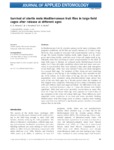Use este identificador para citar ou linkar para este item:
http://www.alice.cnptia.embrapa.br/alice/handle/doc/871215Registro completo de metadados
| Campo DC | Valor | Idioma |
|---|---|---|
| dc.contributor.author | MCLNNIS, D. O | pt_BR |
| dc.contributor.author | PARANHOS, B. A. J. | pt_BR |
| dc.contributor.author | SHELLY, T. E. | pt_BR |
| dc.date.accessioned | 2013-12-10T22:20:34Z | - |
| dc.date.available | 2013-12-10T22:20:34Z | - |
| dc.date.created | 2010-12-29 | pt_BR |
| dc.date.issued | 2013 | pt_BR |
| dc.identifier.citation | Journal of Applied Entomology, Hamburg, v. 137, p. 43-48, 2013. | pt_BR |
| dc.identifier.uri | http://www.alice.cnptia.embrapa.br/alice/handle/doc/871215 | pt_BR |
| dc.description | In Mediterranean fruit fly (Ceratitis capitata) sterile insect technique (SIT) programs worldwide, sterile flies are usually released at 2?3 days of age. However, they usually do not reach full sexual maturity until ca. 5 days of age. We tested whether holding sterile males longer at a fly emergence and release facility, until they were 5 days old, might result in significantly more flies surviving to reach sexual maturity in the field. In large field cages in Hawaii, we released sterile Mediterranean fruit fly males 2 or 5 days old under conditions where food and water were provided, or not provided. Flies were released 2 days after peak emergence in one field cage, while they were released 5 days after peak emergence in a second field cage. The numbers of flies flying out and remaining (dead, dying or non-flying) in the holding boxes were recorded on the day of fly release. At 5 and 8 days of fly age, the size of the male fly populations were estimated using trimedlure-baited traps placed into each of the two field cages for a 30-min period when the numbers of flies trapped were compared. Following six tests (three replications each with and without water and sugar provided), the differences in fly captures (i.e. survival) between 2 days vs. 5 days old releases were highly significant. With food and water provided, several times as many flies from the 5-day-old release field cage were captured at 5 and 8 days of age compared to the 2-day-old release field cage. These differences were magnified under conditions of no food and water provided. Holding Mediterranean fruit flies longer prior to release, requires more holding space and food, but will lead to significantly greater numbers of sexually mature flies in the field. | pt_BR |
| dc.language.iso | eng | eng |
| dc.rights | openAccess | eng |
| dc.subject | Idade de acasalamento | pt_BR |
| dc.subject | Técnica do inseto estéril | pt_BR |
| dc.subject | Moscas-das-frutas | pt_BR |
| dc.title | Survival of sterile male Mediterranean fruit flies in large field cages after release at different ages. | pt_BR |
| dc.type | Artigo de periódico | pt_BR |
| dc.date.updated | 2013-12-10T22:20:34Z | pt_BR |
| dc.subject.thesagro | Entomologia | pt_BR |
| dc.subject.thesagro | Inseto | pt_BR |
| dc.subject.thesagro | Ceratitis Capitata | pt_BR |
| dc.subject.nalthesaurus | Entomology | pt_BR |
| dc.description.notes | Supplement 1. | pt_BR |
| riaa.ainfo.id | 871215 | pt_BR |
| riaa.ainfo.lastupdate | 2013-12-10 | pt_BR |
| dc.identifier.doi | DOI: 10.1111/j.1439-0418.2010.01567.x | pt_BR |
| dc.contributor.institution | D. O. MCLINNIS, USDA/ARS/PBARC; BEATRIZ AGUIAR JORDAO PARANHOS, CPATSA; T. E. SHELLY, USDA/APHIS/CPHST. | pt_BR |
| Aparece nas coleções: | Artigo em periódico indexado (CPATSA)  | |
Arquivos associados a este item:
| Arquivo | Descrição | Tamanho | Formato | |
|---|---|---|---|---|
| Beatriz3.pdf | 165,37 kB | Adobe PDF |  Visualizar/Abrir |









